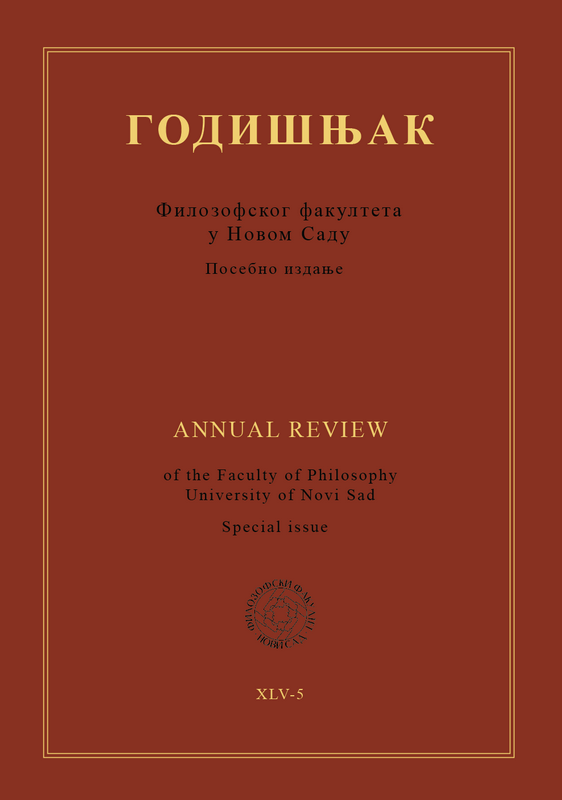DA LI SE PROTOTIPIČNI SEMANTIČKI KONCEPTI USVAJAJU PRVI?
Главни садржај чланка
Сажетак
Najšire prihvaćena podela povratnih glagola jeste trodelna podela na prave povratne, neprave povratne i uzajamno-povratne glagole (Stanojčić–Popović, 2002). Međutim, kako navodi Samardžić (2006), ovakva podela glagola nema jedinstven kriterijum. Dok se tumačenje klitike se pominje kao kriterijum za definisanje pravih povratnih glagola, kod nepravih se njeno značenje ne pominje, već se samo navodi kako se ona ne može tumačiti kao akuzativ povratne zamenice sebe. Kod uzajamno-povratnih glagola se njena uloga uopšte ne pominje. Analizirajući različite konstrukcije glagola sa klitikom se, Rajnhart–Siloni (2003) pokazuju da se reč se javlja kada jedan od argumenata nestane iz sintakstičke reprezentacije. Autorke govore i o derivaciji anti-kauzativnih glagola, kod kojih se spoljašnji argument briše, a unutrašnji obavlja funkciju subjekta (Rajnhart–Siloni, 2005). Cilj ovog istraživanja jeste da se uporedi produkcija pravih povratnih, uzajamno-povratnih i anti-kauzativnih glagola kod dece uzrasta približno 3, 4 i 5 godina (po 20 ispitanika u svakoj grupi). Prethodna istraživanja su pokazala da deca nemaju poteškoća sa usvajanjem povratnih glagola na ranom uzrastu (Snyder, Hyams & Crisma, 1995), dok se očekuje da usvajanje anti-kauzativnih glagola bude otežano (Borer–Wexler, 1987; Brooks–Tomasello, 1999; Roeper, 1987; Bowerman, 1991; Verrips, 2000). Inicijalna hipoteza je bila da se pravi povratni glagoli usvajaju prvi, jer su samo kod njih pristutne dve prototipične tematske uloge (agensa i pacijensa), koje se preslikavaju na funkciju subjekta na nivou sintakse. S druge strane, kod recipročnih glagola su prisutna dva argumenta, koja istovremeno obavljaju i funkciju subjekta i funkciju objekta, dok anti-kauzativne glagole karakteriše sintaksički kompleksan proces derivacije iz tranzitivnog glagola. Istraživanje je sprovedeno pomoću struktuiranih intervjua uz korišćenje unapred pripremljenih vizuelnih stimulusa (crteži), a od dece se tražilo da produkuju glagol prikazan na slikama. Rezultati istraživanja ukazuju na to da deca ne usvajaju sve vrste glagola sa klitikom se istom brzinom. Pravi povratni glagoli se produkuju sa većom tačnošću od uzajamno-povratnih i anti-kauzativnih glagola na različitim stupnjevima razvoja govora. Ovi podaci svedoče o različitom stepenu sintaksičke i semantičke kompleksnosti povratnih glagola i idu u prilog tezi da se prototipične semantičke strukture usvajaju prve.
Downloads
Детаљи чланка
Референце
Arsenijević, N. (2011). Prilog proučavanju povratnih glagola u srpskom jeziku. Zbornik Matice srpske za filologiju i lingvistiku, LIV(1), 115–135.
Bates, D.–Mächler, M.–Bolker, B.–Walker, S.–Bojesen, R.–Singmann, H. & Fox, J. (2019). lme4: Linear Mixed-Effects Models using 'Eigen' and S4. R package version 1.1-21.
Borer, H.–Wexler, K. (1987). The maturation of syntax. In: Roeper, T.–Williams, E. (eds.) (1987). Parameter Setting. Dordrecht: Reidel. 23–172.
Bowerman, M. (1991). When a patient is the subject: sorting out passives, anti-causatives, and middles in the acquisition of English. Paper presented at the symposium on Voice, University of California, Santa Barbara, CA.
Brooks, P.–Tomasello, M. (1999). How children constrain their argument structure constructions. Language, 75, 720–738.
Costa, J.–Friedmann, N. (2012). Children acquire unaccusatives and A-movement very early. In: Everaert, M.–Marelj, M. & Siloni, T. (eds.) (2012). The theta system: Argument structure at the interface. Oxford Studies in Theoretical Linguistics 37. Oxford, UK: Oxford University Press. 354–378.
Eisenbeiss, S. (2010). Using production methods in language acquisition research. In: Blom, E.–Unsworth, S. (eds.) (2010). Experimental methods in language acquistion research. Amsterdam/Philadelphia: Benjamins. 11–34.
Hopper, P. J.–Thompson, S. A. (1980). Transitivity in grammar and discourse. Language, 56, 251–299.
Ivić, M. (1961/62). Jedan problem slovenske sintagmatike osvetljen transformacionim metodom (gramatička uloga morfeme se u srpskohrvatskom jeziku). Južnoslovenski filolog, 25, 137–148.
Kuznetsova, A.–Brockhoff, P.–Bojesen, R. & Jensen, S. (2019). lmerTest: Tests in Linear Mixed Effects Models. R package version 3.1–1.
Ljubešić, N. –Klubička, F. (2016). The Serbian web corpus srWaC. Ljubljana: Jožef Stefan Institute.
Miličević, M. (2015). Između neakuzativnosti i neergativnosti: Povratno, uzajamno-povratno i autokauzativno se. In: Arsenijević, B.–Halupka-Rešetar, S. (eds.) (2015). Srpski jezik u savremenoj lingvističkoj teoriji. Niš: Filozofski fakultet. 175–192.
Pavlinušić, E.–Kelić, M. (2011). Utjecaj poucavanja na ovladanost povratnim glagolima u hrvatskome kao inome jeziku. LAHOR, 11, 5–22.
Pinker, S. (1984). Language learnability and language development. Cambridge, MA: Harvard University Press.
Pinker, S. (1989). Learnability and Cognition: The Acquisition of Argument Structure. Cambridge, MA: MIT Press.
Pinker, S. (1994). How Could a Child Use Verb Syntax to Learn Verb Semantics? Lingua, 92, 377–410.
R Core Team (2017). R: A language and environment for statistical computing. Vienna: R Foundation for Statistical Computing.
Rákosi, Gy. (2008). The inherently reflexive and the inherently reciprocal predicate in Hungarian: Each to their own argument structure. In: König, E.–Gast, V. (eds.) (2008). Reciprocals and Reflexives: Theoretical and Typological Explorations. Berlin and New York: Mouton de Gruyter. 411–450.
Reinhart, T.–Siloni, T. (2003). Thematic Arity Operations and Parametric Variations. OTS working papers in linguistics, TL-03-001, University of Utrecht.
Reinhart, T.–Siloni, T. (2005). The lexicon–syntax parameter: reflexivization and other arity operations, Linguistic Inquiry, 36 (3), 389–436.
Roeper, T. (1987). Implicit arguments and the head-complement relation. Linguistic Inquiry, 18, 267–310.
Samardžić, T. (2006). Reč se u argumentskoj strukturi ditranzitivnih glagola. Naučni sastanak slavista u Vukove dane, 35(1), 179–193.
Siloni, T. (2008). The syntax of reciprocal verbs: An overview. In: König, E.–Gast, V. (eds.) (2008). Reciprocals and Reflexives: Theoretical and Typological Explorations. Berlin and New York: Mouton de Gruyter. 451–498.
Snyder, W.–Hyams, N. & Crisma, P. (1995). Romance Auxiliary Selection with Reflexive Clitics: Evidence of early knowledge of Unaccusativity. In: Clark, E. (eds.) (1995). Proceedings of Child Language Research Forum 26. Stanford, CA: CSLI.
Stanojčič, Ž.–Popović, Lj. (2002). Gramatika srpskog jezika. Beograd: Zavod za udžbenike i nastavna sredstva.
Stevanović, M. (1954). Povratni glagoli. Književnost i jezik u školi, 5, 303–316.
Verrips, M. (2000). Passives and implicit arguments in child language. In: Howell, S. C.–Fish, S.A. & Keith-Lucas, T. (eds.) (2000). Proceedings of the 24th Annual Boston University Conference on Language Development. Somerville, MA: Cascadilla Press. 749–760.




